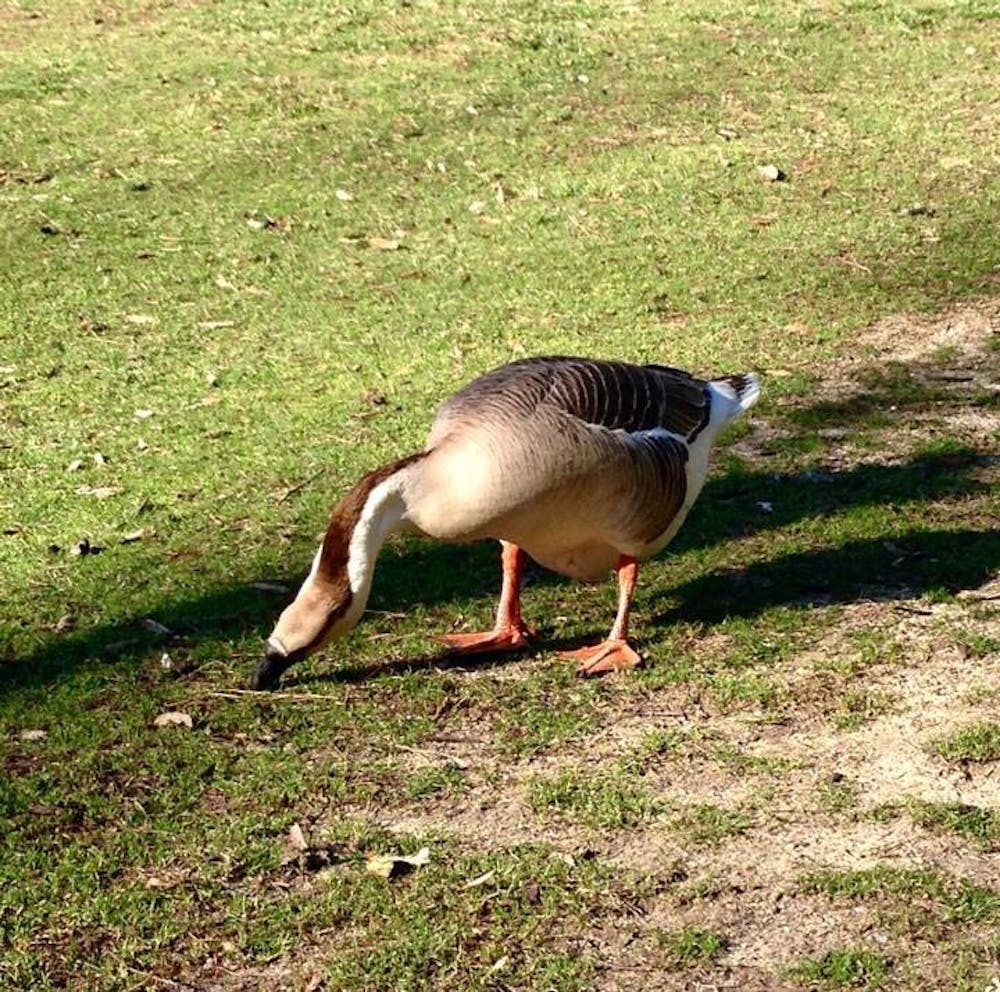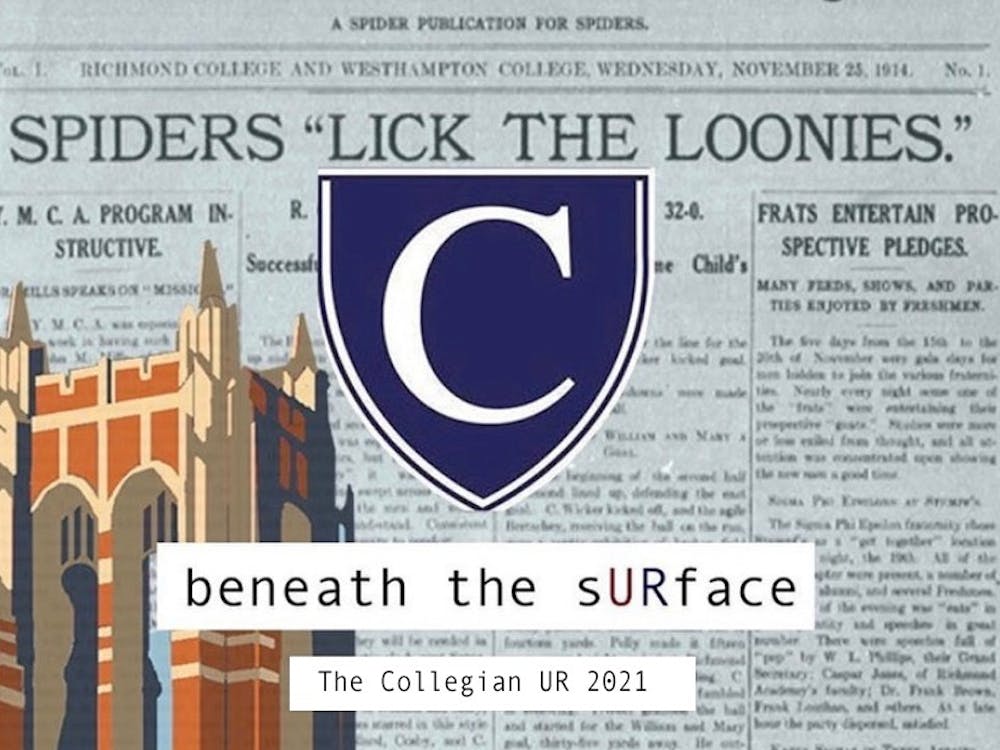In this audio clip, contributor Anna Ridilla explores the possible origins of the iconic humphead goose that roams the University of Richmond campus.
Hosted and produced by Anna Ridilla.
LINDSAY COLFLESH: There's always somebody around talking about him. He's the celebrity of Richmond.
ANNA RIDILLA: Everyone at the University of Richmond knows Triceragoose. It’s a goose. But it’s not like the normal black and white Canada Goose that you see at the park. Triceragoose is… different.
COLFLESH: I would say he's definitely a character. Um, he just does his own thing.
RIDILLA: This is Lindsay Colflesh. And a quick note on Triceragoose’s gender. We don’t actually know if this mythical goose is a male or female. Lindsay calls the notorious white bird a “he.” But other people think he might be a she. Either way. Triceragoose has a reputation as a bit of a menace on campus.
COLFLESH: I heard that he does get very aggressive. And like, sometimes you only see him alone. With an there's no other geese around.
RIDILLA: But other times, Triceragoose is an icon, hanging placidly with other water birds.
COLFLESH: And then he sometimes hangs out with the ducks, which I think is really random.
Enjoy what you're reading?
Signup for our newsletter
RIDILLA: And to cement its legacy as a University of Richmond icon -- Triceragoose is an influencer Her Instagram account has eight-hundred and nine followers and forty posts. But it’s tough trying to get a bird to talk to you. Or really get ANY quote out of a goose. I asked the owner of the Triceragoose Instagram for an interview and they wrote “Honk, I am not able to reveal my true identity,” in true mystical Triceragoose fashion.
If you ask any UR student, the main story you will hear is that Triceragoose attacks first-years.
I talked to Lindsay Colflesh who started as a first-year at UR this semester. It did not take her much time to get acquainted with the notorious Triceragoose.
RIDILLA: How would you describe Triceragoose to a non-UR person?
COLFLESH: Well, it's like, it's white. And then it has orange feet. So like, and it's like a lot bigger than the Canadian geese.
RIDILLA: Like when when did Triceragoose first like enter your radar?
COLFLESH: My um, one of my teammates introduced me to his Instagram. I was like scrolling through it and I saw that he attacked someone.
RIDILLA: Lindsay is a member of the UR cross country team. Are you personally afraid of Triceragoose?
COLFLESH: No, I'm not. I just think he's just funny to watch like, my friend. But yeah, I kind of get concerned for her because she would just like get so close up and take a picture of him. So, knowing that it’s aggressive. Like it could get intense.
RIDILLA: I asked Lindsay if she had been warned about Triceragoose when she arrived on campus.
COLFLESH: Some other people I've heard say be aware of Triceragoose.
RIDILLA: Be aware of him. Like in a scary way like like oh, stay away from him.
COLFLESH: Not like in a scary way, but they're just like warning if you get too close then he's probably gonna attack. He's the celebrity of Richmond, because it's like he's such a trend on in the Richmond campus right now.
RIDILLA: Triceragoose isn’t just a fad though. In fact, there's been a ‘Triceragoose’ on campus for at least 10 years, but nobody knows if it’s the same bird. It’s pretty common for geese to live as long as 10 to 20 years in the wild
Rumor has it that years ago there were actually two Tricerageese: possibly mates. One of them was found dead -- Perhaps an act of revenge from one of the couple’s victims? Maybe a blood thirsty first-year?
It is well known that geese mate for life. The lone Triceragoose now prowls around campus alone -- if she lost her mate could that be the reason she is so aggressive towards students?
To get to the bottom of the Triceragoose myth I talked to Mary Elfner.
ELFNER: Hi. I'm Mary Elfner, and I'm president of the Richmond Audubon Society.
RIDILLA: The Audubon Society is a national organization that seeks to protect birds and their habitats. I met Mary on the edge of the Westhampton Lake. We watched the average geese float by. All I could think about was trying to catch a glimpse of Triceragoose.
The publicity chair for the Richmond Audubon Society, Diane Jadlowski, had suggested over email that Triceragoose might be a Chinese goose which is descended from the wild swan goose in China. So Mary and I started there.
ELFNER: These birds differ from the wild birds in much larger size, and in having this really strong developed basil knob on the upper side of the bill, which you've noticed before. So that's some of the distinguishing characteristics.
RIDILLA: I pulled up some reference photos to compare Triceragoose with the much more common type of goose on campus.
ELFNER: The kind you're showing me is called Canada Goose. And its common name is chinstrap goose. And they are wild. So they're wild enough, like they're not really pets.
RIDILLA: Why do you have any idea why it might be the only goose that looks like that on campus?
ELFNER: It could have been a pet. And it could have escaped or someone could have let it go. The Chinese goose it's a breed of domesticated goose. And that's why I say it was probably somebody's pet was because these are not wild geese.
RIDILLA: So also another thing that's like the rumor on campus is that this goose is more aggressive than some of the Canada geese
ELFNER: Domesticated geese tend to be more aggressive than wild geese. When I was in college, interestingly enough, I went and visited my husband's family for the first time and in rural South Carolina, and they had a white domestic goose called bird bird. And that bird attacked me the entire time we were there.
RIDILLA: So should students be afraid of Triceragoose?
ELFNER: Well, definitely respect the Triceragoose and if it comes at you, you know, I'm not going to it. This is hard for me to say as the president of the Audubon Society, but you know, you got to kind of show it who's boss. You know, it's just trying to assert its territory.
RIDILLA: So, students should assert their territory.
ELFNER: Yes, I think so. In a, as nonviolent manner as possible.
RIDILLA: Okay, and should students generally stay away from Triceragoose and all the geese?
ELFNER: I know it's a really tough order because people love to feed birds that they find on lakes, but there's good reason not to, so I would give them their space.
RIDILLA: Okay, so working hypothesis, he was maybe domesticated and got loose
ELFNER: Could have been a pet. Yep. Could have been two of them originally that were pets.
RIDILLA: We may never be sure where Triceragoose came from but I buy Mary’s hypothesis. Triceragoose may have been a pet-- maybe it was banished for being *too* aggressive -- but now she is bigger than any one bird. From a simple animal… to an urban myth… AND an unofficial school mascot, she is likely to remain popular among students for years to come.
Contact contributor Anna Ridilla at anna.ridilla@richmond.edu.
Support independent student media
You can make a tax-deductible donation by clicking the button below, which takes you to our secure PayPal account. The page is set up to receive contributions in whatever amount you designate. We look forward to using the money we raise to further our mission of providing honest and accurate information to students, faculty, staff, alumni and others in the general public.
Donate Now



